.
“SEO without keywords doesn’t exist”, says Brian Dean, founder at Backlinko.
After the BERT update, all old blogs on Keyword Research become trash. Long-tail keywords are dead…
It demanded a new keyword strategy and a deeper knowledge on types of keywords. And once executed right, you garner years of traffic and making $$$… Small or Big website.
The article taps into that underrated strategy… step-by-step to help you uncover profitable keywords, your competitor doesn’t even know about.
.
Content Snap
What are keywords in SEO?
Keywords Definition: phrases that search engines (like, Google, Bing) look for to understand the nature of the content better. And on the basis of it (and other signals like internal links), ranks the blog.
Speaking in SEO, phrase having decent search volume, making some search logic, and relevant to your niche is known as Keyword.
Relevant niche means… MediCap is all about medical science.
…phrases like “how to predict stock market” (irrelevant niche) have no SEO importance for it.
Bloggers use them while writing their blogs. Marketers use them in tuning the funnels. And brands target them to bring customers to their website. (something for everyone 😊)

Easing out… I’ve shown what keywords you’ve to look for depending on the phase of your writing.
Deconstructed phases into 4 parts:
1. Before you start writing,
2. At the time of researching,
3. Completed but not published,
4. After Publishing.
Phew… Let’s dive in!
.
Phase 1 – keywords to search before you start writing the blog
Every blog has a definite purpose.
Introspect to understand it is informative (e.g., How to or guides) or commercial (e.g., product reviews) article.
E.g., How to find competitive keywords (informative purpose)
E.g., Best Keyword Research tool (commercial purpose)
Difference between Informative Keyword and Commercial Keyword
| Informative Keyword | Commercial Keyword |
| Bloggers use them to nurture the leads and showing their expertise | Affiliate business and Advertising agencies use this term to demonstrate their tools/services in action |
| Done to capture emails | Done to drive sales |
| Have higher search volume | Have higher CPC |
| Modifier — How to, Ultimate guide, Definitive guide, tips of, etc. | Modifier — Best, Comparison, Free shipping, under 5000, etc. |
| Example — How to build Backlinks | Example — Best Tool to build Backlinks |
.
Brian Dean’s business model revolves around informative keywords. He capture the email, build relations with subscribers, and then pitch his services or his course “SEO that works”… telling this to let you know, every blogger is always selling!
.
Similarly, every searcher has peculiar intent…
.
And after the Rank Brain update, Google can decipher the searcher’s intent behind keywords or any search query.
Rank Brain is a propriety machine-learning Ai technology of Google. It helps the Google to understand the searcher’s intent behind the keyword. Thereby, Rank Brain ranks the blogs accordingly.
Above was the holistic overview of current Google’s Algorithm.
Therefore, understanding the searcher’s intent = what answers searcher is looking for the particular query… eminent for bloggers to know.
.L
Intent targeting keywords
Suppose, Searcher types Neil Patel’s Age
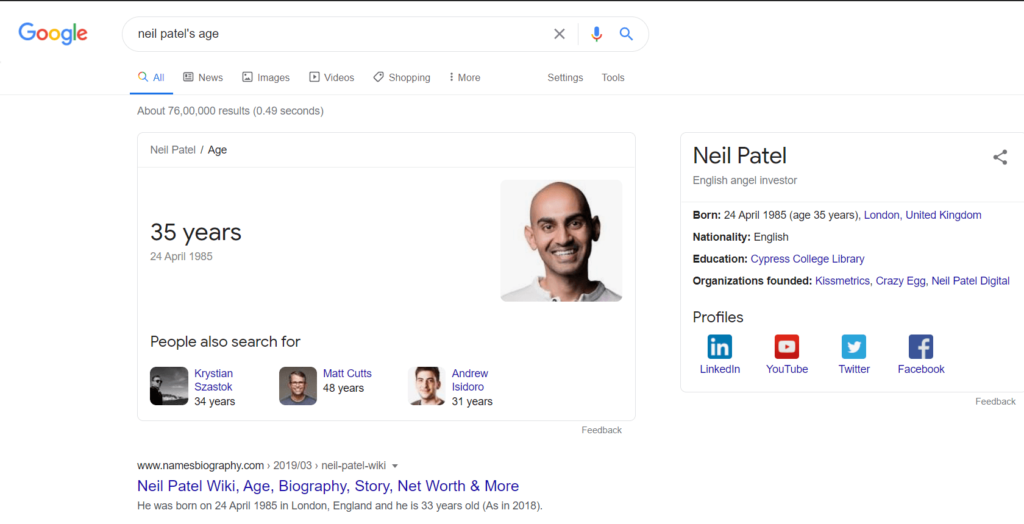
Intent – just wanted to know the age
Google exactly answers it in one word. This answer box is called answer snippet. And on the right – knowledge graph to share more info.
Searcher types Neil Patel’s blog
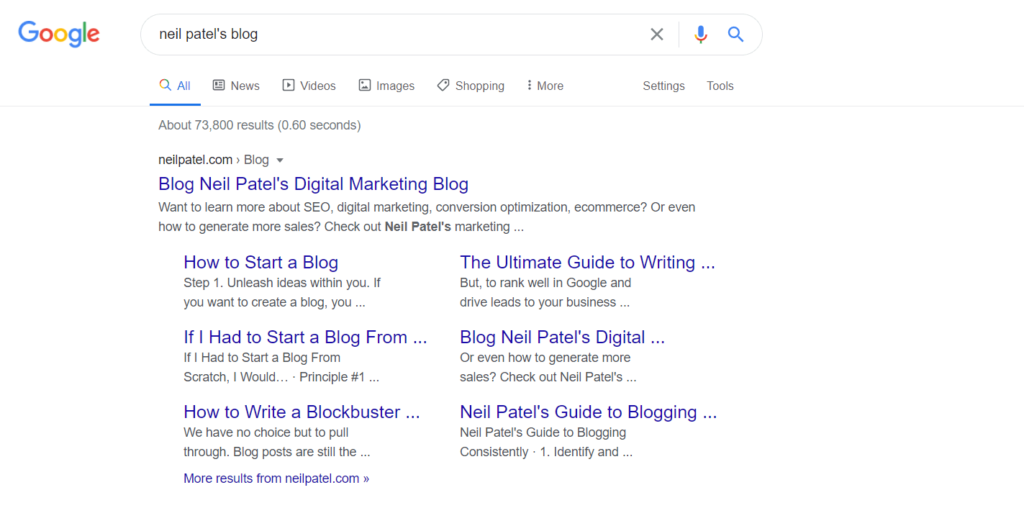
Intent — Searcher wants to know more about Neil Patel.
Google shares the blog page to navigate.
SEO Tip – observe how good structure the Neil blog is (also known as website architecture). This happened due to correct submission of schema markup.
One more time… Searcher types Neil Patel’s services.
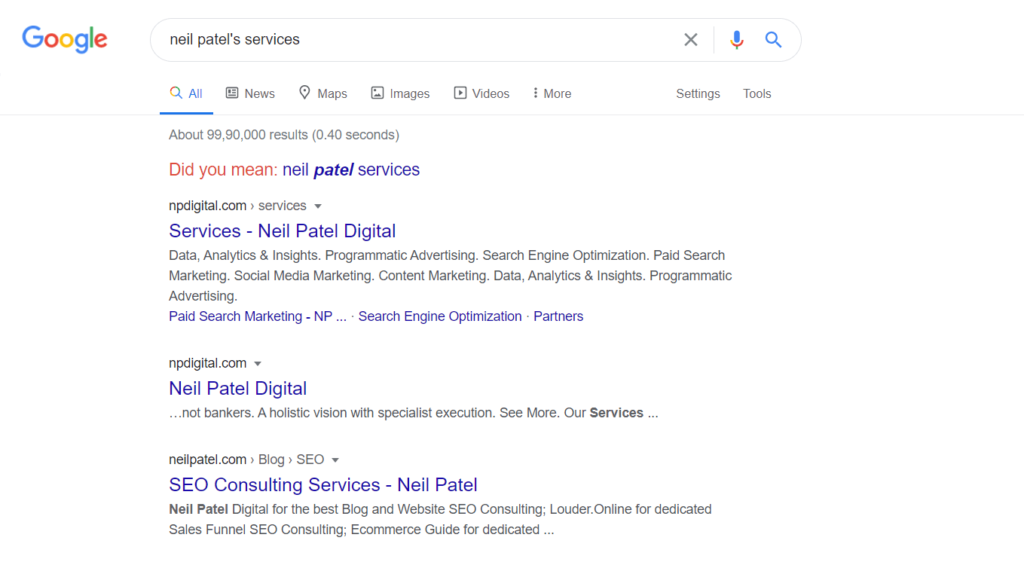
Intent — Searcher wants to know what Neil Patel’s services are. Searcher is interested in availing services from him.
Google shows “npdigital.com” (Neil’s marketing agency).
.
Now, For deciphering searcher’s intent, there are 3 keywords divided as:
Informational Query (know query)
The first case. Just concerned with info. No purchasing intent nor interested in reading deeper.
Includes — Knowledge graph.
SEO Fun Fact — SearchEngineLand found Informational Query constitutes to 80% of the Google searches.
Navigational Query (Go query)
The second case. Concerned with the product. Moderate purchasing intent. And would navigate around the web page.
Includes — Home Page, About us page.
Transactional Query (Do query)
The third case. Concerned with the services. High commercial intent and reader would spend high on-page time on the particular webpage.
Includes — Agency website, Contact us page, Sales page.
These intent based keywords are widely used by Ecommerce brands in syncing the buyer’s journey. Hence, improving their sales funnel.
.
Intent-keyword example for E-commerce Industry
| Informational Query | Navigational Query | Transactional Query | |
| Brand’ s (e.g., Nike) affiliates use these terms to build the product’s awareness. | Searcher query focused in that particular brand (here, Nike). | Now, the searcher is well aware of the brand and convinced Nike sells good quality shoes. So, decides to purchase. | |
| E.g., qualities of good sports shoes. | E.g., Nike sports shoes, Nike running shoes. | E.g., ‘deals on nike sports shoes’, ‘nike sports shoes offers’ or searches nike sports shoes on Amazon. |
Marketing Advice – if buyer didn’t search by himself… target him via Ads.✌
.
But ranking on these terms for brands isn’t easy as one-night stand. Brands need a marketing funnel… targeting keywords in every channel. This helps in achieving visibility at every stage.
Primarily, funnel is divided into 3 parts. And every part meets with different keyword.
Market Defining Keywords
- Phrases that define your industry. They are broad and generic.
- Constantly building content and optimizing web pages around these phrases… help you to get your website found to the targeted audience.
- Added benefit, helps you explore a similar niche website you can collaborate with.
E.g., running shoes, wordpress seo.
Product keyword
- Keywords that targets the brand’s product.
- Brands need to optimize web pages for these phrases, so their customers can found them.
- Searcher is looking for a specific brand product, have high commercial intent, and he wants to know in-depth about the product.
E.g., nike running shoes, dell laptop.
Customer-defining keyword
- It’s a subset of market defining keyword.
- Customer attributes added, hence query becomes more specific.
E.g., running shoes for women, running shoes for teen.
That’s why knowing the audience is so important for brand building.
Done the survey (or audience research) right, you can become visible to targeted audience by optimizing the content accordingly.
In my case, my buyer’s persona are clients who avail my copywriting (like Facebook Ad copy) and SEO blogging services. Their profession (majorly) marketing managers and start-up founders. Their age is between 24-35. And they are in-general male.
PRO Tip – If you’re a freelancer/agency, knowing buyer’s persona is inevitable. Observe who were your past clients and frame an avatar from that.
.
And talking about services, businesses are heavily influenced by location factor.
Geo-Targeted keywords.
Phrases that are dependent on geography. It is of two types:
Local keywords
E.g., restaurants in Agra (local)
They are targeted by brick-and-motor business.
SEJ suggests, Local keywords are NOT restricted to town or city. You can optimize content around neighboring areas or a country too. This would widen your customer base and helps in brand recognition in longer run.
Global Keywords
E.g., best restaurants in the world
They are targeted by Marketing and Tourism agencies.
.
Since, freshness of the content is among the 200 ranking factors of Google… And freshness depends on nature of topic.
Evergreen Topic – Topic which will remain relevant for many years to come. Concept based study (like this, keyword research topic) will bring traffic for long time.
Topical Topic – seasonal demand. Brings traffic for short duration. E.g., Halloween’s dress or Valentine’s gift.
To determine this, either brainstorm or let Google do thinking.
If you’re like me, you’d choose the 2nd one.
.
E.g., upcoming web series – you’ll notice queries 5 days new.
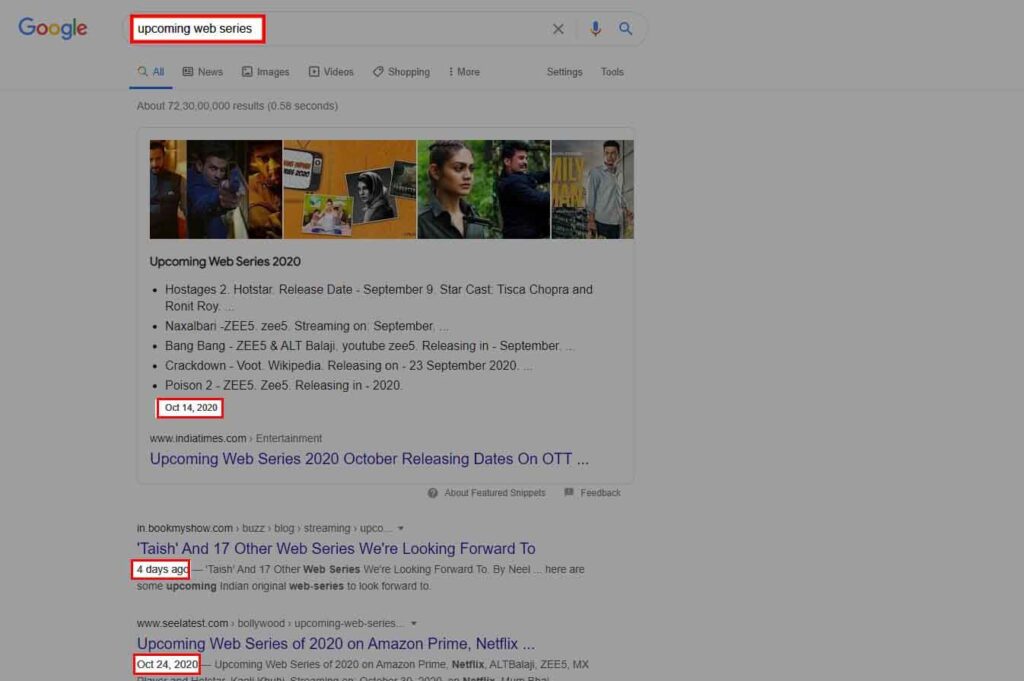
E.g., keto diet for vegetarians – you’ll notice queries 2 years old. This shows the evergreen nature of the content.
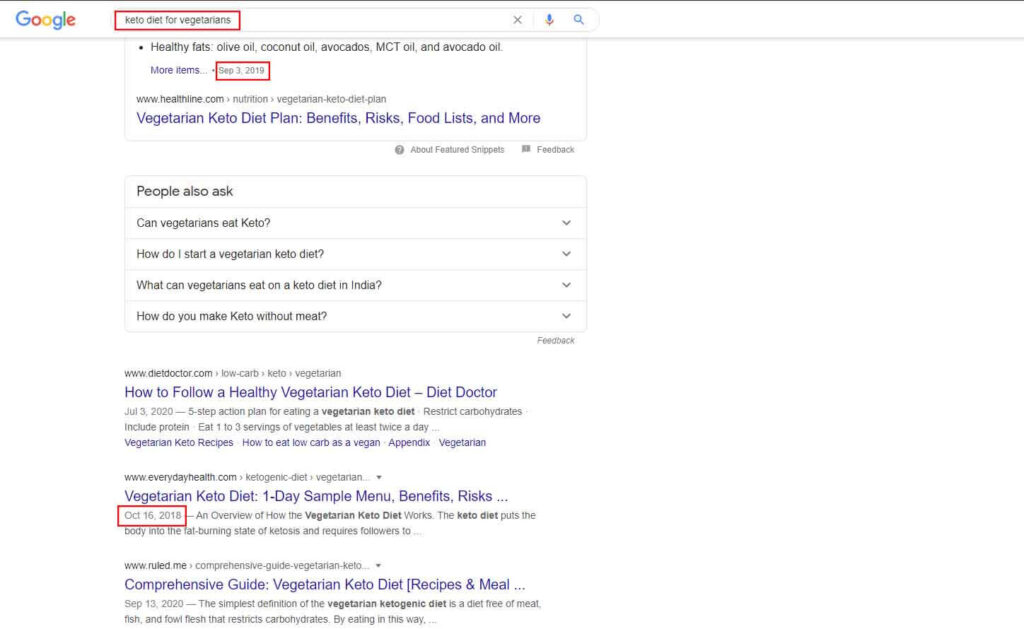
.
Due to topic’s time-dependent nature, gave rise to 2 types of keywords:
Evergreen Keywords
Keywords explaining a core concept. Brings consistent traffic.
E.g., how to know if you are pregnant.
Topical Keywords or Seasonal Keywords
Keywords which bring huge traffic but for short span of time. Having time factors like ‘this week’, ‘upcoming’, ‘today’s’, ‘festival name’, etc.
E.g., movie this week.
.
Now, you’ve sufficient knowledge to start the research… but before vetting in keyword process mud, perform these two tests:
.
Google Trends Test
This is the frontier step
Why?
We all think our blog topic is out-of-the-box and would generate thousands of views because of the unique content.
But people only read those things which they find a need. So, better create content popular among readers.
Google trends exactly shares the popularity score. It scales relative to 100… more the better.
Type a generic keyword (will define it later). Observe the graph for time period 3 months and 12 months. Making sure a consistent popularity… to reward your efforts.
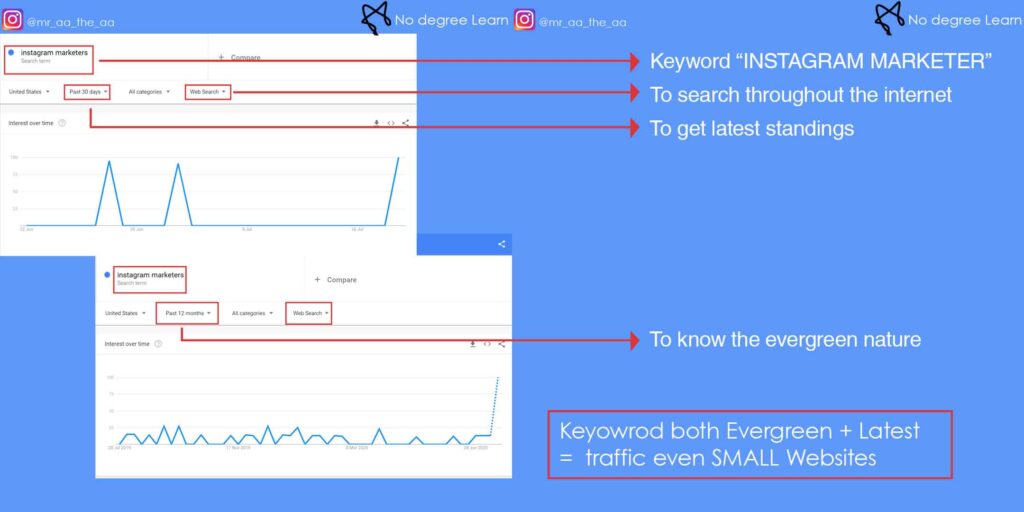
Search Analysis and Moz DA Test
Read this carefully, because this well reveal how I analyze search results.
[DA – Domain Authority. It shows how credible the site is. Higher it is, bigger the organic influence it has.]
Query “types of keywords” It showed ONLY 4 articles relevant. Rest the queries are keyword research guide.
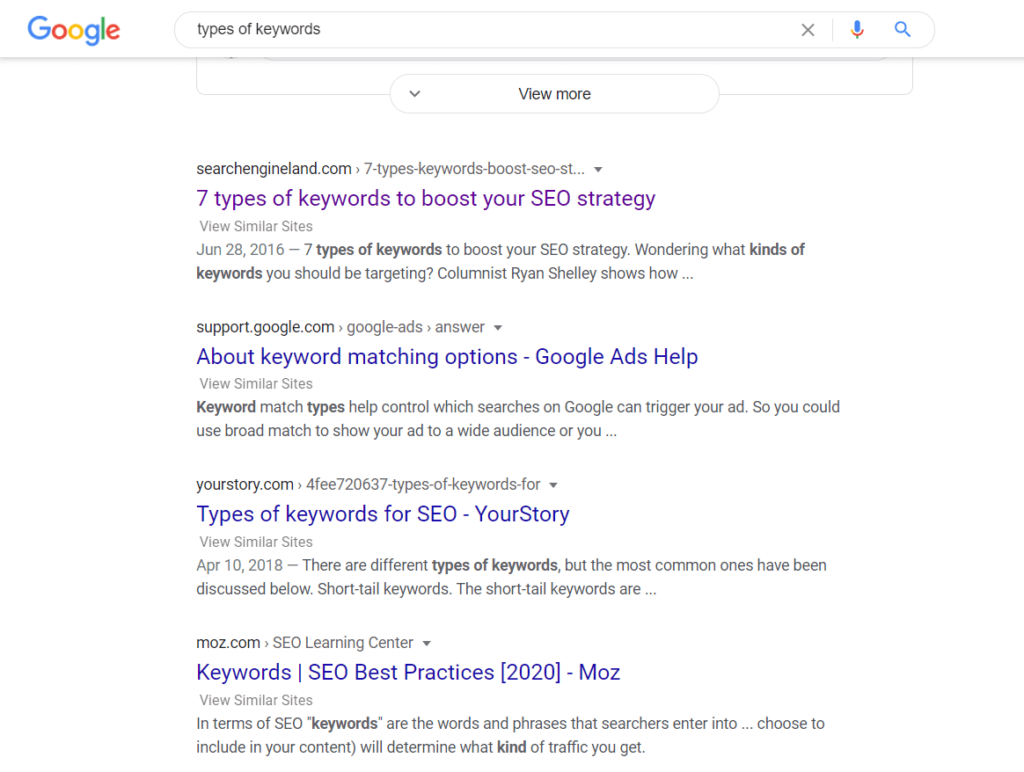
Then, the idea hit me to merge both topics.
Also, this would make the content comprehensive, and plenty of takeaways for my readers.
Now, to get more from search query… install Moz DA chrome extension; free analysis tool.
Run the test, found two search queries having almost nil backlinks. Hence, the position is EASY to crack. I started mining.

Note – Like I’ve done SERP analysis for a single search result… for understanding the position of blog, I’ll do competitor analysis. I’ve explained this in-depth using free tool, Ubersuggest.
.
Phase – 2 At the time of researching for Keywords
Here, you’re clear with the topic to write, knows your niche. So, let me help you to find profitable keywords.
Seed Keyword
Seed Keyword or head keyword Moz defines, it is the word which you “think”. It’s the central theme of your content. And all the other related keywords are generated from this seed keyword. Having higher search volume. It is also known as keyword head. Or parent keyword, as per Ahrefs.
E.g., On-page SEO
Long-Tail Keyword (LTK)
Users typing them wants a specific answer. And that’s why they have less search volume but high conversion-rates.
Use this formula to determine Long-tail keyword:
Long-tail keyword = Seed Keyword + Modifier
E.g.,
tea or coffee + which has more caffeine.
On-page SEO + latest trends
Modifier are the additional words depending on:
- CPC,
- searches/month,
- searcher’s intent,
- SEO difficulty score.
SEO misconception – Long-tail keywords are 3-4 words long.
Fact – there is nothing such ideal word length. I’m glad Eugene Lata, CMO at SerpStat, spotted that back in 2016.
.
Difference between Seed Keyword and Long-tail Keyword
| Seed Keyword | Long-tail keyword |
| Higher search volume | Lesser search volume |
| Generally, Higher Keyword difficulty | Generally, lower keyword difficulty |
| Poorer click-through rates | 2.5 times higher click-through rates |
| Suffers huge competition | Faces lesser competition |
| Multiple search intent | Looking for a specific answer |
| E.g., t-shirts | E.g., American round-neck t-shirts |
.
SEO mis-conception – Longer words have lesser search volume.
Fact – Search volume entirely depends on industry and searcher behavior. And independent of number of words in the keyword.
Consider this keyword example (taken from Ahrefs):

Numbers don’t lie, Longer word phrase brought higher search volume.
And as we said, seed words have higher volume than LTK. Hence, ‘lose weight’ here is the LTK and ‘How to lose weight’ is a seed word… NOT THE REVERSE.
Similarly, seed words can be longer than 1-2 words. Determinant factor is the search volume.
Don’t listen to me, HEAR OUT from Tim Soulo, CMO @ Ahrefs.
“You cannot judge keyword nature from it’s word length. And you cannot determine search popularity from looking at the words length.”
.
Anatomy of a Keyword
A Keyword has three sections: Head, Torso, and Tail.
Example, Keyword = Blue Round-Neck T-shirts

.
Note – Since we discussed, Google don’t rely on words but the intent. Hence, optimizing the entire blog for one Long-tail keyword is DEAD in 2020, says Brian Dean.
So, now you cannot rank for one LTK, what we can do?
Rank on multiple Long-tail keywords. Yay!
For this I’ve one EXPERTS-PROVEN strategy, but before spitting out… you need to know these 2 terms:
.
Primary Keyword
Yoast plugin users know it as Focused keyword. You “ideally” wanted to get rank for this term. Can be Long-tail or Seed keyword. Generally, it has high search volume and good commercial intent.
Places Bloggers insert primary keywords terms in the website to ensure SEO:
- Title
- H1 tag
- H2, H3 tags
- Image Alt text
- Image Alt Title
- Meta Description
- In the FAQ Schema
- Introduction, Conclusion
- Slug – keywords in the URL.
Here’s the blog by Neil Patel:
Affiliate Marketing Made Simple: A Step-by-Step Guide
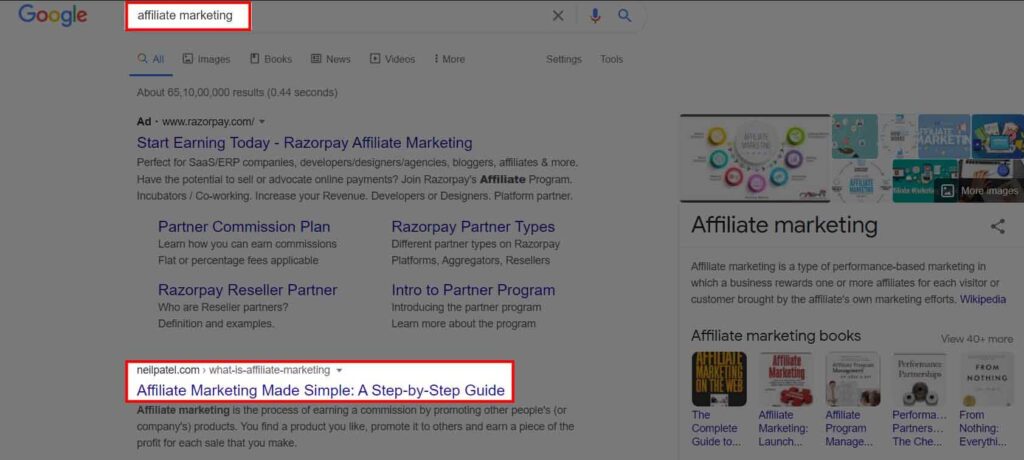
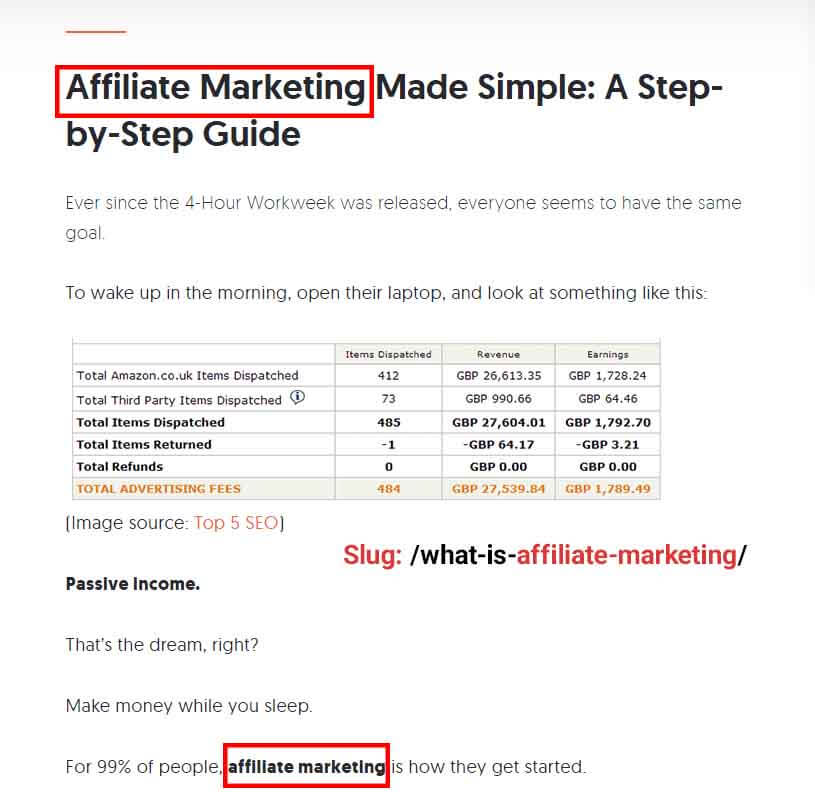
(The prime keyword is Affiliate Marketing)
This is one of the best optimized-page in the affiliate marketing industry.
He has inserted primary keyword at every mentioned place.
.
Secondary Keyword
All other keywords which your webpage is ranking for. In this case – what is affiliate marketing, affiliate marketing for beginners, affiliate marketing programs… 5k++ other keywords.

That being said,
it’s time to REVEAL the keyword strategy 😁
.
Keyword clusters
It sounds short and sweet, but it has a power to bring tons of traffic from 100s of keywords at auto-pilot mode.
In the simplest way, I’ve explained keyword clusters…
In keyword clusters, it’s grouping of multiple small-topics in a more in-depth into a one blog post. And covering those topics by optimizing with search phrases audience is using.
.
How Keyword Clusters work?
I’ll use this blog creation (as an example) to show how it works. (I use the same proprietary process in optimizing my clients’ blog posts as well)
Now, for experts it is easy – do a PAID tool test and explore all the content topics and keyword.
But I’d tell you the FREE Keyword tool way!
.
Step 1 — Finding Content Topics
Topic ideas from Google Trends
Copy the terms from related suggestions. These are terms people are searching “currently”.
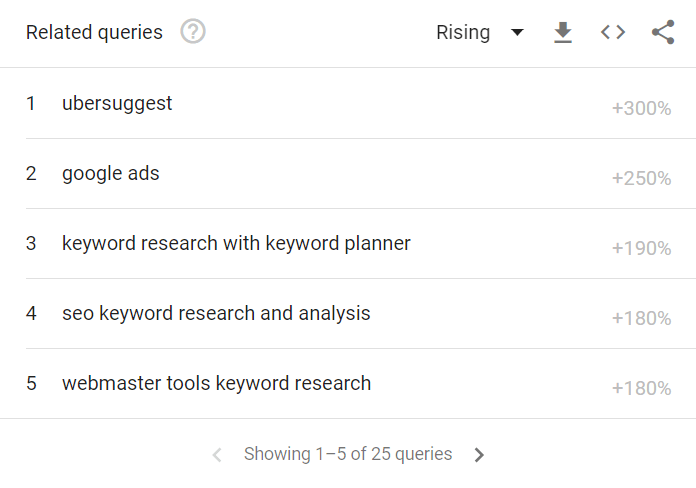
Go to Answer the Public
Best tool to get all the topic threads.
Follow the carousel to understand how to Answer the Public.
Leverage Quora and Reddit
They are the biggest public forums on the planet.
.
At the end of this… you would know the WANTS of the searchers.
.
Step 2 — Finding Long-tail Keywords
LTK would help you in improving the understanding the relevant queries people are looking for. And search phrases they are commonly using.
Leverage Google search in Incognito mode.
It is the best long-tail keyword research tool. Type the relevant query and hit “double space” or “*”. Auto-suggestion will do the job. These are phrases — popular, diverse, and people type to know about the topic.

.
Leverage Google related searches
Did you know, who understands Google the best?
The Google!
These are the terms Google thinks are “algorithmically” alike to what searcher has typed.
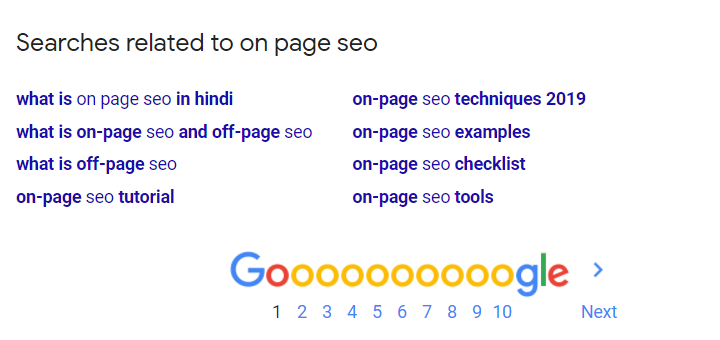
.
Keyword research with Google Keyword Planner
Best tool for bulk keyword research. All the variations in the keywords you get for free.
Also, you’ll get the monthly search volume.
Don’t vouch for the competition difficulty. That’s for the advertisers, none important for organic explorers.
Copy all the keywords as a CSV file or G Sheets.

.
Keyword research with Ubersuggest
Ubersuggest, a free keyword tool by Neil Patel, is s swiss knife for any blogger on low-budget (like me).
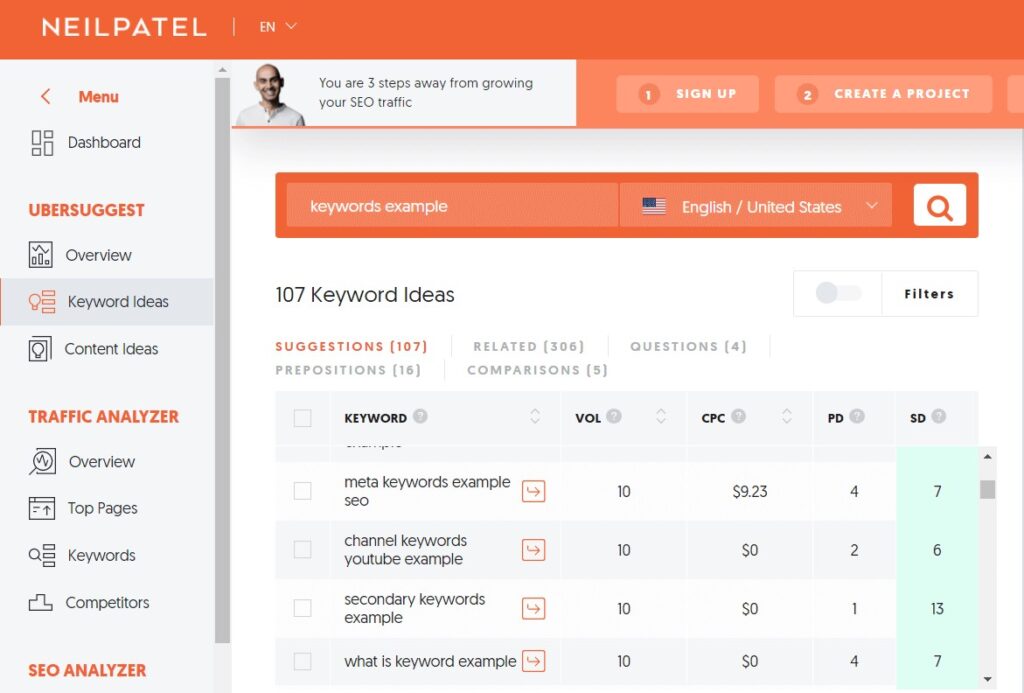
Just type the word and Go to keyword ideas.
Keywords segregated into 5:
- Suggestions — generates LTK for the term
- Related — I find it alike suggestions
- Prepositions (my favorite) — shows variations in the search phrase. Mixing up with ‘with’, ‘for’, ‘in’, etc.
- Questions — Any interesting question comes in, add that in FAQ schema. Scroll the end to see my FAQ schema.
- Comparisons — queries like A versus B, A difference B, A or B are present. They have the least search volume but easy to rank for.
To become Ubersuggest’s pro-user, read this helpful Review cum guide on Ubersuggest.
,
Keyword research Tip
While collecting keywords, make sure they are relevant to your topic. Like in this “Keyword research”… I found ‘keyword example in c’, ‘Keywords for resume’, etc. and they are not my types 😛
Since, Google relies on intent… I know I’ve said this before but it bears repetition, so… IGNORE keywords which are misspelt, incorrect grammar, plural forms.
Here are few examples I found while finding profitable keywords:
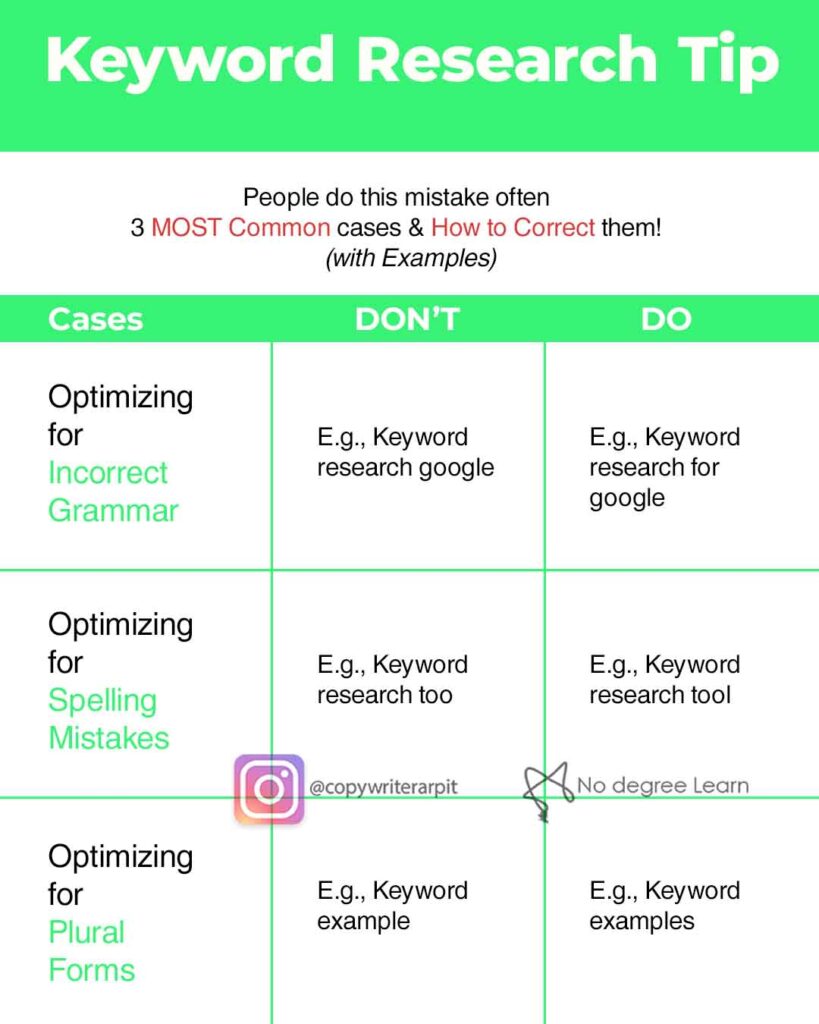
Step 3 — Paste the keywords on MS-Excel or Google Sheets
After seething through…you’ve collected the relevant queries.
Total LTKs I explored were 53. I’d recommend you to search atleast 40.
You are eligible to go for next step, if you can answer:
- Sub-Topics people are interested on,
- Phrases to people are using to search for it,
- Your prime keywords (In my case, two prime keywords: types of keywords, keyword research).
.
After this step, QUERIES meet the WANTS.
.
Step 4 — Grouping of the words
For grouping
Primary keyword in center with topics on circumference.
See, how I group them.
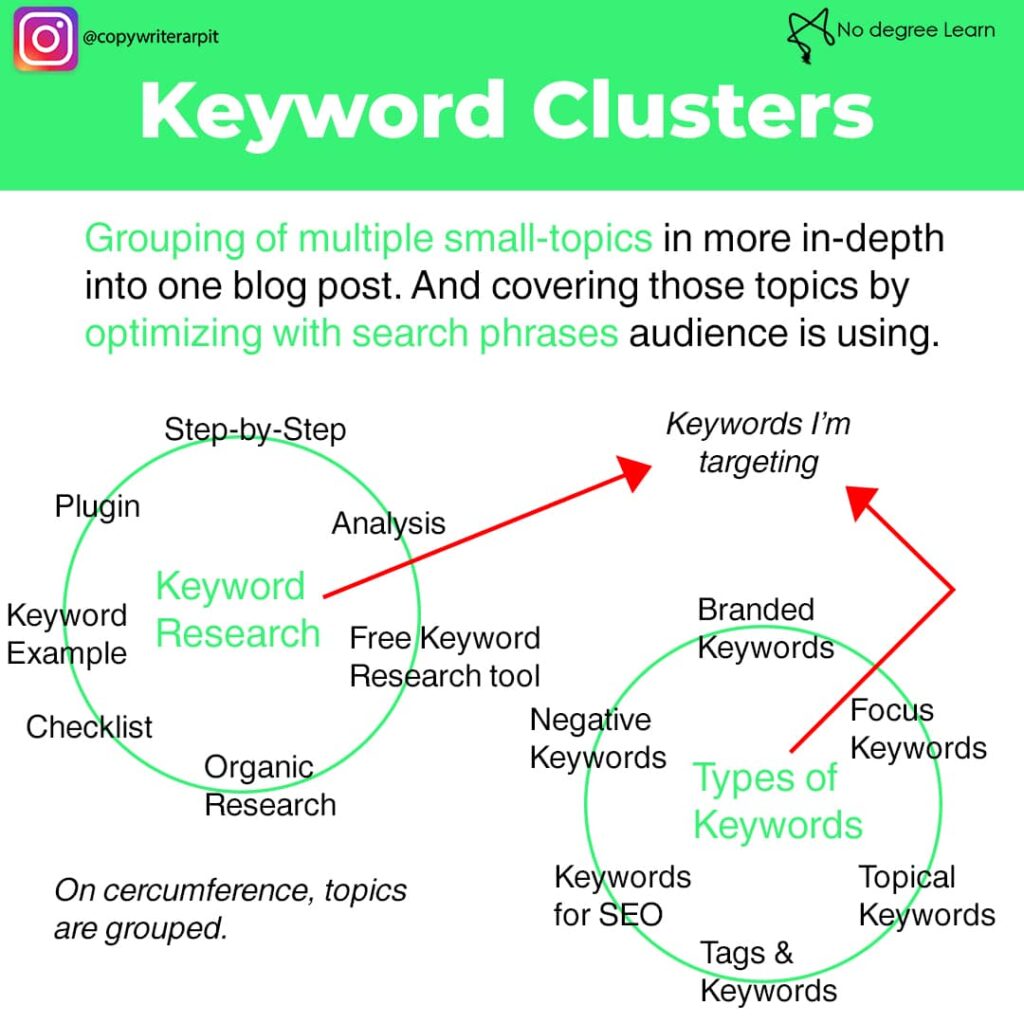
Here’s another example from Simplilearn:

.
Grouping is done, to have an understand which keyword fits for what topic. And since we know search terms (people use), when writing those topics…. I’d sprinkle it in the content.
.
Fair Warning:
I shared a side-note to analyze search queries before starting keyword research… because:
This Keyword clusters (or any other search method) depends industry or niche, Competition for the topic, search volume for the phrases.
Suppose you’re from SEO or Marketing industry then Keyword clusters work wonders.
But if you’re from fitness industry, then keyword clusters may not work.
Because topic – tea or coffee + modifier
modifiers are for weight loss, for cancer, caffeine content, etc.
People have made blogs for each modifier.
What you should do? So, niches (like fitness or diet or finance) better you write individual blog post on each modifier. And go deep in answering the query.
.
Phase — 3 After you’ve written the blog but Unpublished
Check for Keyword Stuffing
Google is now stringent about it. And would penalize blogs if cought.
Keyword Stuffing
It’s an outdated SEO practice where bloggers try to rank for a particular phrase (or keyword). They do so by shoving a particular phrase in the content.
.
What is Keyword Stuffing in practice?
Suppose, I want to rank for “on-page SEO tips 2020” phrase…. repeating (stuffing) this phrase just to get rank on it, won’t solve the purpose. And this notion is agreed by Rand Fishkin, Neil Patel, and other top SEO experts.
How you can prevent Keyword Stuffing?
Sometimes when writing a blog, a particular “phrase” we tend to repeat more. And this can be a negative signal for the Google.
Google is now better understanding the natural language (using NLP techniques) in your content.
Adding up, repeating words is disturbing for the readers as well. To solve this problem, Free Copywriters Tool – wordcounter.net
Step 1 — Paste your article in the workspace.
Step 2 — For quick analysis, go through the three words volume. Obviously, is, an, for… don’t constitute in keyword stuffing
.
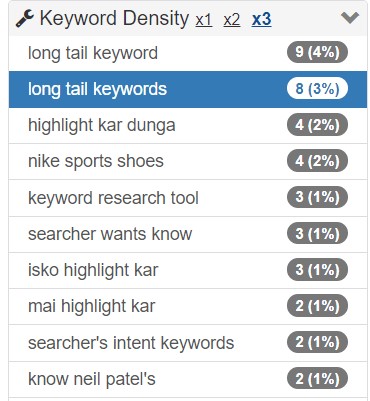
You noticed… first two phrases have more frequency… So, I replaced that shit with LTK at few places.
Smart, I know.
Optimizing for LSI
Latent Semantic Indexing (LSI) helps Google in ranking blogs on terms a “searcher meant” but “haven’t specifically typed that (latent)”. You typed A query… but the blogs were optimized for B query. Yet A and B having semantic relation, Google shows B as a result.
LSI Example
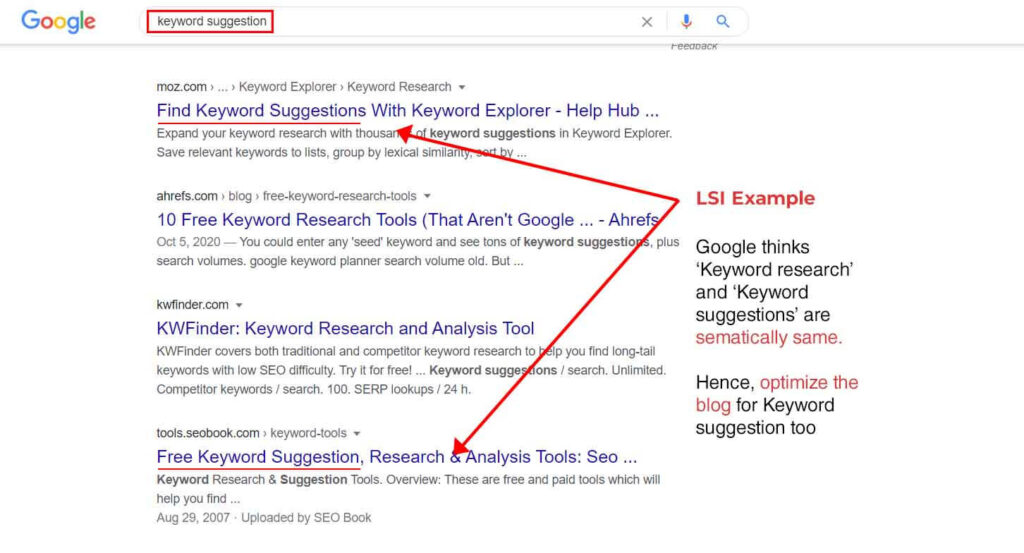
Also, many SEO experts say, Google is a huge thesaurus. Owing these traits Google can identify what you want to say, your logic behind the query without searcher “necessarily” typing that.
.
FREE Tools to optimize for LSI
1. LSI graph, a freemium LSI tool. Before hitting the publish button, I checked semantic words from it… there I discovered ‘Keywords suggestion’ from this tool.
2. Watson Natural Language Understanding Tool. The tool auto-generates LSI words by using machine learning. Also, describes the emotions (happiness, anger) would evoke after reading the content.
.
When Google auto-ranks for LSI words then why to insert them?
Fair question.
End of the day, behind Google is a robot… and better you guide that robot, easier your content will rank.
.
Places you can insert LSI
1. Meta Description
Optimized Meta Description yields 5.8% more clicks. Inserting LSI would help your query getting highlighted. And hence, your SERP stands out.
2. Throughout your blog post
Shows thumbs up to the Google bot… and he’ll likely to rank the blog higher for the semantic search.
.
Like, LSI helps with Meta Description, the next keyword helps brand in writing better titles.
.
Title Tags
Words appear in the Title, one which you see in the SERP of the query, is known as Title Tags.
To check Title tags of ANY web page — press ctrl/cmd + u then use ctrl/cmd + f and type “<title>”.

Note — <title> famous brands include their brand’s name here <\title>
This brings me to the next keyword and to tell you the benefits using them.
.
Branded Keywords
keywords which include the brand’s name or brand’s acronym or brand’s tagline. Used in the title tags. Done to improve the organic click-through rate.

.
Benefits of using Branded Keywords:
1. Builds trust.
2. SE Journal found for #1, #2, #3… Branded keywords get higher clicks than regular keywords.
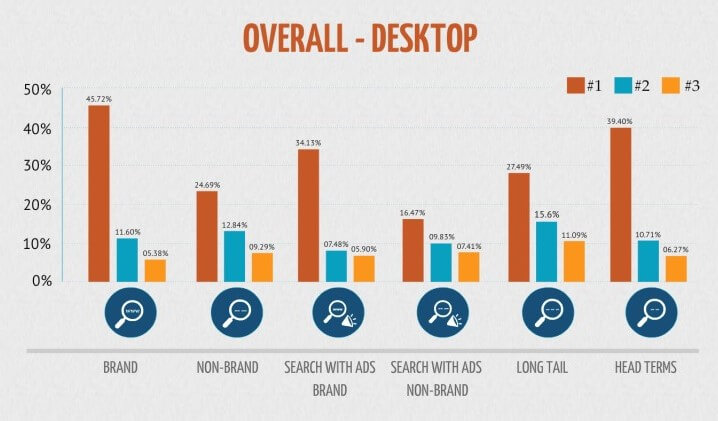
3. Positions you as a thought leader.
4. Get easily ranked when a searcher has typed your brand name as a query.
5. By Neil Patel, a positive sign when people search brand name… shows people are talking about you.
.
When you’ve to optimize for branded keywords
Step 1 – Go to your Google Search Console panel
Step 2 – Performance tab >> Check the Search Appearance and Impression
Step 3 – Now search that your Brand name is appearing.
Note – If you’re a small website (or DA < 40), I won’t recommend you using Branded keywords. Because very few would be typing your brand’s name. Instead use those characters in writing an EYE-CATCHY title.
.
Difference between meta tags and keywords
| Keywords | Meta Tags |
| Appear front-end. | Appear back-end |
| Affects the readability. | Doesn’t affect the readability. |
| Keywords are used by search engines to show blogs for that query. | Tags are self-written by bloggers. |
| Keywords include – Seed words, branded keywords, etc. | Meta Tags include – meta description, title tags, etc. |
.
FYI – Interested in reading meta tags in-depth… Morris, Moz writer, did a great job in compiling it.
.
Competitor Keywords
Keywords in which A brands competes against B brand on the B’s branded keyword.
Earlier, it was used by only Ad agency. You type the keyword Adidas, and it shows Nike too in Google Ads.
But with evolving creativity, brands are using in blog writing for Affiliate marketing. This technique is known as cross-promotion.
.
How do I know this?
*story time*
I worked with a Healthcare Affiliate agency, they cross-promote supplements.
In this, you target a bigger brand keyword (like they targeted TestoMax). They give a product review… but such highlighting the weakness of the product. And then, they cross-promote their own products. And tells readers, how it’s better than the former supplement.
Note – I believe, it’s a fair practice because you are just telling the weakness of the product (all claims linked to authentic sources).
.
Benefits of competitor’s keywords for bloggers
1. You’re attracting the right audience. Because you’re targeting the right competitor.
2. Since you’re writing 2 reviews in one blog post… hence, longer blog length. Obviously, would rank well.
3. Remember you targeted bigger brand. Hence, you leverage the traffic bigger brand has.
.
Phase 4 — When you’ve written a blog post.
Opportunity Keywords
The concept is shared by Backlinko.
Suppose, I’ve published the blog.
I’m tracking it via Google Search Console’s performance tab. Analyzing only impressions and the search position. After some time (in my case, 2 months), I analyzed… keywords I’m “already” ranking for in page 3,4, and 5. Yet people are looking for it, impression is proof of that.
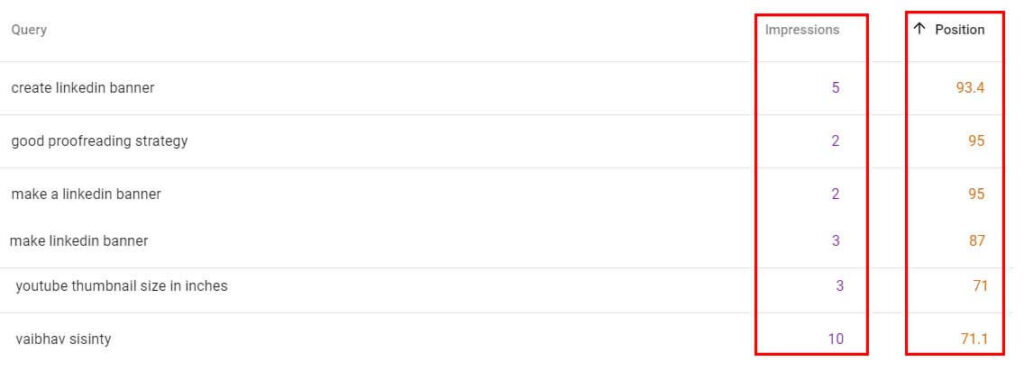
Now, I would go to my WordPress dashboard, sprinkle those words which I’m already ranking… after some time, voila it would improve my rankings for the particular term.
.
Keyword research and strategy Mistakes for Bloggers
Mistakes that I did:
1. Relied heavily on keyword search volume
Analyzing search results for the targeted keyword and Google Trends test is the foremost. Only after then, optimizing the content around the keyword would make sense.
2. Not inserting keywords in H3 and H4 tags
Keywords should be well spread throughout the blog. Gives positive signals to Google.
3. Writing meta-description in a hurry
Now, I strategize to optimize them with LSI terms.
4. Using the exact keyword phrase too many times
This is a BIG NO.
This comes under radar of Keyword stuffing. And it’s a negative signal for Google. To eliminate this, just write like there are no keywords. And in the end, I sprinkle them throughout my blog.
.
Mistakes that everyone makes
Optimizing the whole blog for one Long-tail keyword
In the Brian’s words “Long-tail keyword optimization is dead.”
Solution — Use the Keyword Cluster (explained above) to optimize the content
Word length determines Long-tail Keyword
It is a “general trend” NOT a rule.
Relying on Meta Keywords
2008 outdated concept. Google, Bing, and Yahoo announced they don’t rely on Meta Keywords.
They are intentionally written keywords to influence the bots to rank higher for those terms. But now, searchers have stopped relying on it.
And I’m stressing on NOT to use meta keywords because “meta keywords” phrase still gets 170 searches/month… so, if you think they work, Google bot is smart to rank the content without them.
.
Conclusion & Takeaways
Keyword strategy would help you get your blog found quicker… and only way if you too a small blog owner. And for that, we discussed different types of keywords – uses and examples.
Applying keyword clusters and analyzing search results. Using Google Trends test to determine topic popularity.
Then, understanding how Google uses LSI to interpret searches. And how you can leverage LSI to get more free views.
Lastly, we discussed about the keyword mistakes and how you can avoid them.
.
Here’s an exercise – pick any random topic and find keywords from Google auto-suggest, Keyword planner, etc., and topic ideas from Answer the public. Now, apply grouping technique of keyword clusters to interpret which keywords would get you found on those topics.
.
FAQ
Keyword research is important because search engine look for these phrases to rank your content. Optimizing your content would get you rank better by the search engines. And optimized blog means more traffic… means more inbound leads.
Every keyword is searched with different intent. Hence, knowing the keyword types would help in deciphering the search intent better.
Adding up, helps you tuning the marketing funnels (for marketers), developing SEO strategy (for bloggers and SEO executives), and targeting the right audience (for brands).
Every Keyword is a Search Query but NOT every Search Query is a Keyword.
Query is any term real-human inputs on Google search. It can have misspellings, grammar errors, unparliamentary terms, etc.
Keyword is a filtered term, having some search volume and marketing relevancy.
Keywords are used by marketers and SEO executives in strategizing the campaigns. Terms appear on Google’s auto-complete are keywords.
E.g., dolchie gabana, Dolce and Gabbana and people are nuts about it, Dolce and Gabbana online store (search queries)
E.g., Dolce and Gabbana (keyword)
keyword research tools used in this step-by-step guide: Google Keyword Planner, Ubersuggest, Moz DA Checker, and Google Search.
Keywords include: informative, navigational, and transactional. Informative shows searcher wants to know about a product. Navigational he wants to about the particular brand’s product. And transactional, he is making a purchase of the particular brand product.
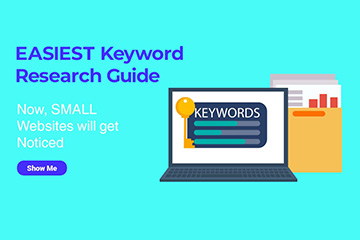


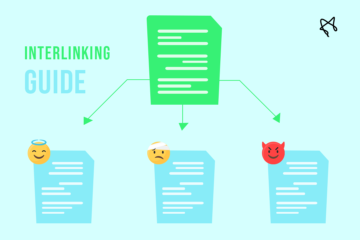


0 Comments